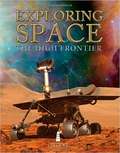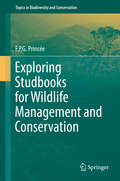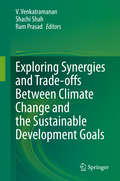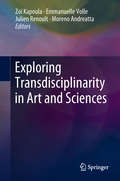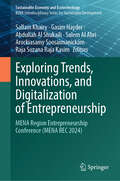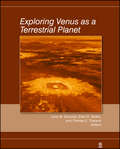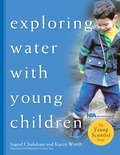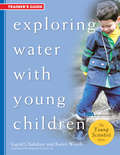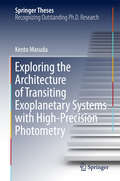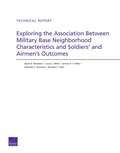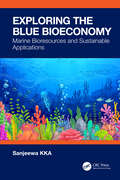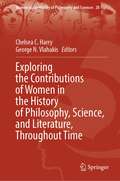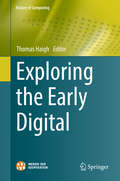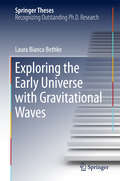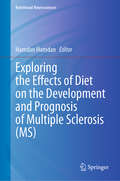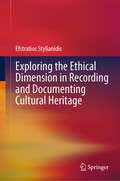- Table View
- List View
Exploring Science [Grade 5]
by Malcolm B. Butler Kathy Cabe Trundle Randy L. BellThis student edition covers 100% of Grade 5 Next Generation Science Standards.
Exploring Space (Comic Strip Science Adventures #2)
by Paul MasonAn entertaining collection uncovering amazing stories of space exploration told in comic strips.Discover the history of the first missions to the Moon, how space rovers have adventures, the mystery of a floating poo and much more. This book is sure to entertain children, while giving them an insight into the many challenges and rivalries behind scientific achievements and how scientists learn from mistakes. It is produced by the same team as Comic Strip Science with hilarious comic strips illustrated by award-winning artist Jess Bradley and written by Paul Mason, who is well known for making science learning fun. Key science concepts are pulled out in more depth in feature spreads. The book has a specialist text consulant, Sophie Allan of the National Space Centre.Comic Strip Science Adventures is a series of comic books that are perfect for young scientists aged 7 plus. Each book has specialist subject consultants. Titles in the series: Digging for Dinosaurs, Exploring Space, Medical Marvels Amazing Inventions.
Exploring Space: The High Frontier
by Jones BartlettSpace Technology, Exploring Space, Manned and Unmanned Spaceflight, The Space Environment.
Exploring Studbooks for Wildlife Management and Conservation (Topics in Biodiversity and Conservation #17)
by F.P.G. PrincéeMany endangered species of wild animals are managed in captivity through studbooks. In this book these data-rich resources are mined in innovative, integrated and statistically tested ways to maximise information gain for conservation practice – whether for captive or released/reintroduced or managed wild populations. This book is thus an important tool for all species managers, and for students and researchers in small population biology and wildlife conservation.The book's studbook analyses are grouped in three interrelated sections: natural history, demography and genetics. Statistical tests to determine the significance of results or to compare results between subgroups are undertaken throughout. Real studbooks of a variety of species, e.g. cranes, wolverines, blesbok, illustrate the practical applications and interpretations of the analyses and statistics. The “natural history” section presents analyses to determine baseline species information such as litter size, inter-birth interval, longevity and seasonality. “Demography” covers census(-style) analyses, age-class based life tables, comparative survival analyses and population projections. Solutions for dealing with small sample sizes are included.Inbreeding depression and unconscious selection form the main focus of the “genetics” section. Survival and life table analyses are used to assess inbreeding effects. Quantitative genetics methods are applied to natural history traits as a tool to monitor genetic variation. A fourth section on “conservation” shows how data from captive populations can be used where natural history data from wild populations are missing. A real example uses studbook data to inform Population Viability Analysis. The final section deals with issues related to incomplete and missing data and statistical topics.The purpose-written open-source software programs “Population Management Library (PML)” and “studbookR” used for analyses in the book, are available at www.princee.com.
Exploring Synergies and Trade-offs between Climate Change and the Sustainable Development Goals
by Ram Prasad Shachi Shah V. VenkatramananThe existential environmental crisis prompted the United Nations to formulate the Millennium Development Goals at the turn of the 21st century in order to embark on an era of sustainable development. The progress and deficiencies in achieving the Millennium Development Goals provided impetus to the intelligentsia and policymakers to map out the pertinent goals for a sustainable growth trajectory for humanity and the planet. The United Nations’ 2030 Agenda for Sustainable Development, which was adopted in September 2015, took the shape of 17 Sustainable Development Goals (SDGs) and 169 targets. In effect, the 17 Sustainable Development Goals focus on protecting the earth's life support systems for intra- and inter-generational equity and for development that is rooted in sustainability science. Attaining these goals is an uphill task; nevertheless, scientific knowledge, trans and interdisciplinary inquiries, concerted global action and capacity building would provide an enabling environment for achieving the SDGs. This book explores the synergies and trade-offs between climate change management and other SDGs. It highlights the policy imperatives as well as the interrelations between combating climate change and its impacts (SDG 13) and food and nutritional security (SDG 2), water security (SDG 6), soil security (SDG 15), energy security (SDG 7), poverty eradication (SDG 1), gender equality (SDG 5), resilient infrastructure (SDG 9), and sustainable and resilient cities (SDG 11).
Exploring Traditional Wild Edible Plants (Exploring Medicinal Plants)
by Rahul Datta Sachidanand Singh Vibhor AgarwalWild edible plants are native species that grow and reproduce naturally in their natural habitats without domestication. These plants can serve as a healthier alternative to farmed crops that may be heavily laden with pesticides and other poisonous substances. This book focuses on assessment of the nutritional value, potential health benefits, and mechanisms of action of various wild edible plants. It presents information on nutrients and bioactive ingredients that can have health advantages, including antioxidant properties, antimicrobial, anti-inflammatory, and antidiabetic effects.Features: Comprehensive exploration of potential benefits as well as side effects of wild edible plants. Special emphasis is placed on diversity, category, and pharmacological values of wild edible plants. Discusses challenges regarding the usage of wild edible plants such as overharvesting and habitat destruction, safety, and toxicity. A volume in the Exploring Medicinal Plants series, this book highlights bioactive compounds and therapeutic efficacies of various wild edible plant species. It is useful reading for scientists, researchers, academia, and plant scientists interested in the health benefits of wild edible plants.
Exploring Transdisciplinarity in Art and Sciences
by Zoï Kapoula Emmanuelle Volle Julien Renoult Moreno AndreattaThe book is organized around 4 sections. The first deals with the creativity and its neural basis (responsible editor Emmanuelle Volle). The second section concerns the neurophysiology of aesthetics (responsible editor Zoï Kapoula). It covers a large spectrum of different experimental approaches going from architecture, to process of architectural creation and issues of architectural impact on the gesture of the observer. Neurophysiological aspects such as space navigation, gesture, body posture control are involved in the experiments described as well as questions about terminology and valid methodology. The next chapter contains studies on music, mathematics and brain (responsible editor Moreno Andreatta). The final section deals with evolutionary aesthetics (responsible editor Julien Renoult).Chapter "Composing Music from Neuronal Activity: The Spikiss Project" is available open access under a Creative Commons Attribution-NonCommercial 4.0 International License via link.springer.com.
Exploring Trends, Innovations, and Digitalization of Entrepreneurship: MENA Region Entrepreneurship Conference (MENA REC 2024) (Sustainable Economy and Ecotechnology)
by Gasim Hayder Sallam Khairy Abdullah Al Shukaili Salem Al Abri Arockiasamy Soosaimanickam Raja Suzana Raja KasimThe primary audience of the proceedings includes a broad spectrum of proactive readers who actively participate in the exploration of the field of entrepreneurship research. This comprises of scholars, who are professors, researchers, and scholars that are publishing papers and conducting researches regarding to entrepreneurship. Also, the proceedings aim at the BL/G guests – undergraduate and postgraduate students – keen on the discovery of the recent trends, novelties, and knowledge concerning the topic of entrepreneurism. Thus, for the undergraduate students, the proceedings are useful to obtain the basic information concerning the given subject areas and understand the key principles at play, while the postgraduate students can share the fresh information and methodologies introduced in the articles that can be helpful for their own research. Furthermore, the proceedings are directed towards people with specific interests in entrepreneurship research, be they practitioners, consultants, policymakers, or entrepreneurs. Such people may practice business, finance, technology, or social entrepreneurship and want to be aware of the tendencies in the entrepreneurial field. The audience inclusion policy guarantees that irrespective of the level of the user: a beginner, an undergraduate, a masters or a doctoral candidate, or a professional, the information applicable and beneficial, in solace to one’s level of study or work. In appealing to such a wide range of people, the proceedings seek to create a prosperous and diverse population of entrepreneurial scholars and entrepreneurs and to advance the generation and dissemination of knowledge in the subject area.
Exploring Venus as a Terrestrial Planet
by Thomas E. Cravens Larry W. Esposito Ellen R. StofanPublished by the American Geophysical Union as part of the Geophysical Monograph Series, Volume 176.With the search for extra-solar planets in full gear, it has become essential to gain a more detailed understanding of the evolution of the other earth-like planets in our own solar system. Space missions to Venus, including the Soviet Veneras, Pioneer Venus, and Magellan, provided a wealth of information about this planet' enigmatic surface and atmosphere, but left many fundamental questions about its origin and evolution unanswered.This book discusses how the study of Venus will aid our understanding of terrestrial and extra-solar planet evolution, with particular reference to surface and interior processes, atmospheric circulation, chemistry, and aeronomy. Incorporating results from the recent European Venus Express mission, Exploring Venus as a Terrestrial Planet examines the open questions and relates them to Earth and other terrestrial planets. The goal is to stimulate thinking about those broader issues as the new Venus data arrive.
Exploring Water with Young Children
by Karen Worth Ingrid ChalufourLooking at science in a new way, Exploring Water with Young Children focuses children's explorations to help deepen their understanding of water and its properties--including concepts related to water's flow, appearance and effect on objects. The third unit in the Young Scientist Series, this field-tested curriculum supports the early development of important science inquiry skills such as questioning, investigating, discussing and formulating ideas and theories.Karen Worth is a graduate-level instructor in the early childhood education department at Wheelock College.Ingrid Chalufour has designed and conducted training programs for a variety of early childhood staff for more than 35 years. Both authors live in Newton, Massachusetts.
Exploring Water with Young Children, Trainer's Guide
by Karen Worth Ingrid ChalufourThe trainer's guide serves as an indispensable handbook for trainers and administrators interested in introducing staff to the Exploring Water with Young Children curriculum--from planning to implementation. From exploring sinking and floating to using books to extend science learning, seven basic and eight advanced workshops develop staff members' understanding of science and inquiry teaching skills. The guide also includes strategies for supporting teachers over time through mentoring and guided discussions, as well as an extensive resource list.
Exploring and Optimizing Agricultural Landscapes (Innovations in Landscape Research)
by Lothar Mueller Frank Eulenstein Viktor G. Sychev Nikolai M. DroninThe book informs about agricultural landscapes, their features, functions and regulatory mechanisms. It characterizes agricultural production systems, trends of their development, and their impacts on the landscape. Agricultural landscapes are multifunctional systems, coupled with all nexus problems of the 21th century. This has led to serious discrepancies between agriculture and environment, and between urban and rural population. The mission, key topics and methods of research in order to understanding, monitoring and controlling processes in rural landscapes is being explained. Studies of international expert teams, many of them from Russia, demonstrate approaches towards both improving agricultural productivity and sustainability, and enhancing ecosystem services of agricultural landscapes. Scientists of different disciplines, decision makers, farmers and further informed people dealing with the evolvement of thriving rural landscapes are the primary audience of this book.
Exploring the Architecture of Transiting Exoplanetary Systems with High-Precision Photometry (Springer Theses)
by Kento MasudaThis thesis develops and establishes several methods to determine the detailed geometric architecture of transiting exoplanetary systems (planets orbiting around, and periodically passing in front of, stars other than the sun) using high-precision photometric data collected by the Kepler space telescope. It highlights the measurement of stellar obliquity – the tilt of the stellar equator with respect to the planetary orbital plane(s) – and presents methods for more precise obliquity measurements in individual systems of particular interest, as well as for measurements in systems that have been out of reach of previous methods. Such information is useful for investigating the dynamical evolution of the planetary orbit, which is the key to understanding the diverse architecture of exoplanetary systems. The thesis also demonstrates a wide range of unique applications of high-precision photometric data, which expand the capability of future space-based photometry.
Exploring the Association Between Military Base Neighborhood Characteristics and Soldiers' and Airmen's Outcomes
by Laura L. Miller Gabriella C. Gonzalez Sarah O. Meadows Jeremy N. V. Miles Brandon T. DuesThis report explores the applicability of neighborhood theory and social indicators research to understanding the quality of life in and around military bases. It also highlights gaps in neighborhood study methodology that need to be addressed in future research. Finally, it outlines how a more in-depth neighborhood analysis of military installations could be conducted.
Exploring the Blue Bioeconomy: Marine Bioresources and Sustainable Applications
by Sanjeewa KKAExploring the Blue Bioeconomy: Marine Bioresources and Sustainable Applications provides an overview of marine bioresources in the blue bioeconomy for readers curious about the blue bioeconomy. It delivers potential applications of marine macro and microorganisms in different industries such as biomedical, functional food, pharmaceutical, cosmeceutical, ecotourism, industrially important minerals, and enzymes. Besides the potential industrial applications, the book gives the readers an overview of conversion and sustainable utilization techniques for marine bioresources.Key Features Discusses the major sectors associated with the blue bioeconomy and the future potential of each industry for both developed and developing countries. Covers the most important aspects of seaweeds with respect to commercialization and conservation, including botanical information. Includes a discussion about potential future applications of marine microorganisms in the blue bioeconomy with research highlights. Explores the potential industrial applications of marine nematodes and their role in future agriculture and heavy metal remediation applications. Summarizes circular economy principles, upcycling, and recycling approaches to marine litter management under the context of the blue bioeconomy. The book begins by providing an overview of the blue bioeconomy and then advances through the chapters to discuss potential industries, organisms, and conservation techniques to protect ecosystems and associated organisms from overharvesting and pollution. Thus, readers with any level of educational background can easily understand the content of this book. The content of this book is suitable for undergraduates, postgraduates, industrialists, and policymakers who are working in the different fields of blue bioeconomy.
Exploring the Contributions of Women in the History of Philosophy, Science, and Literature, Throughout Time (Women in the History of Philosophy and Sciences #20)
by Chelsea C. Harry George N. VlahakisThis book explores contributions by some of the most influential women in the history of philosophy, science, and literature. Ranging from Sappho and Sophie Germain to Stebbing and Evelyn Fox Keller, this work ultimately demonstrates the impact these non-canonical, sometimes unknown or hidden, sources had, or may have had, on the recognized male leaders in their fields, from Aristotle to Pascal, Kant, Whitehead, and Russell. Chapters reflect philosophical pluralism, both analytic and continental themes, and cover figures reaching across the entire history of ideas in the West, from pre-historic times to the twentieth century. Anyone interested in coming to know or in preparing to teach women in the history of philosophy, science, and literature will appreciate this collection and its myriad insights into the still unrecognized voices of non-canonical sources across these disciplines.
Exploring the Crack in the Cosmic Egg: Split Minds and Meta-Realities
by Thom Hartmann Joseph Chilton PearceThe classic follow-up to the bestselling The Crack in the Cosmic Egg • Explains the process of acculturation and the mechanisms that create our self-limiting “cosmic egg” of consensus reality • Reveals how our biological development innately creates a “crack” in our cosmic egg--leaving a way to return to the unencumbered consciousness of childhood • Explores ways to discover and explore the “crack” to restore wholeness to our minds and reestablish our ability to create our own realities In this classic follow-up to his bestselling The Crack in the Cosmic Egg, Joseph Chilton Pearce explains the process of acculturation and the mechanisms that create our self-limiting “cosmic egg” of consensus reality. Laying the groundwork for his later classic Magical Child, Pearce shows that we go through early childhood connecting with the world through our senses. With the development of language and the process of acculturation not only do our direct experiences of the world become much less vivid but our innate states of nonordinary consciousness become suppressed. Trapped in a specific cultural context--a “cosmic egg”--we are no longer able to have or even recognize mystical experiences not mediated by the limitations of our culture. Motivated primarily by a fear of death, our enculturation literally splits our minds and prevents us from living fully in the present. Drawing from Carlos Castaneda’s writings about Don Juan and the sense of “body-knowing,” Pearce explores the varieties of nonordinary consciousness that can help us return to the unencumbered consciousness of our infancy. He shows that just as we each create our own cosmic egg of reality through cultural conditioning, we also innately create a “crack” in that egg. Ultimately certain shifts in our biological development take place to offset acculturation, leaving an avenue of return to our primary state. Pearce examines the creation of the “egg” itself and ways to discover its inherent cracks to restore wholeness to our minds, release us from our fear of death, and reestablish our ability to create our own realities through imagination and biological transcendence.
Exploring the Early Digital (History of Computing)
by Thomas HaighChanges in the present challenge us to reinterpret the past, but historians have not yet come to grips with the convergence of computing, media, and communications technology. Today these things are inextricably intertwined, in technologies such as the smartphone and internet, in convergent industries, and in social practices. Yet they remain three distinct historical subfields, tilled by different groups of scholars using different tools. We often call this conglomeration “the digital,” recognizing its deep connection to the technology of digital computing. Unfortunately, interdisciplinary studies of digital practices, digital methods, or digital humanities have rarely been informed by deep engagement with the history of computing.Contributors to this volume have come together to reexamine an apparently familiar era in the history of computing through new lenses, exploring early digital computing and engineering practice as digital phenomena rather than as engines of mathematics and logic. Most focus on the period 1945 to 1960, the era in which the first electronic digital computers were created and the computer industry began to develop. Because digitality is first and foremost a way of reading objects and encoding information within them, we are foregrounding topics that have until now been viewed as peripheral in the history of computing: betting odds calculators, card file systems, program and data storage, programmable calculators, and digital circuit design practices. Reconceptualizing the “history of computing” as study of the “early digital” decenters the stored program computer, repositioning it as one of many digital technologies.
Exploring the Early Universe with Gravitational Waves
by Laura Bianca BethkeThis work investigates gravitational wave production in the early universe and identifies potentially observable features, thereby paving the way for future gravitational wave experiments. It focuses on gravitational wave production in two scenarios: inflation in a model inspired by loop quantum gravity, and preheating at the end of inflation. In the first part, it is demonstrated that gravitational waves' spectrum differs from the result obtained using ordinary general relativity, with potentially observable consequences that could yield insights into quantum gravity. In the second part, it is shown that the cosmic gravitational wave background is anisotropic at a level that could be detected by future experiments. Gravitational waves promise to be an rich source of information on the early universe. To them, the universe has been transparent from its earliest moments, so they can give us an unobstructed view of the Big Bang and a means to probe the fundamental laws of nature at very high energies.
Exploring the Effects of Diet on the Development and Prognosis of Multiple Sclerosis (Nutritional Neurosciences)
by Hamdan HamdanThis book offers an insightful exploration into the relationship between diet and Multiple Sclerosis (MS), aiming to address a crucial question: Can dietary interventions serve as effective preventative and therapeutic measures for patients with MS? Delving into this question, the book examines various nutritional components and regimens, shedding light on their potential impacts on the progression, relapse rate, and development of MS. It offers readers valuable insights into how dietary choices can influence the management of this condition. Backed up by evidence gathered from review and clinical trial papers, the book discusses the role of vitamins such as A, B, and D, as well as dietary supplements like caffeine, carnitine, and lipoic acid in benefiting patients with MS. Particular attention is given to the significance of vitamin D in lowering the risk of developing MS and its immunomodulatory effects on the inflammatory processes associated with the disease. In parallel, the book also addresses the detrimental effects of diets such as the Western or high salt diet (HSD) on MS prognosis, emphasizing how these dietary regimens can harm the gut microbiome and exacerbate inflammatory responses, ultimately promoting demyelination of the central nervous system (CNS). The book then explores alternative dietary approaches that confer a protective effect on the gut microbiome and the CNS, including whole grain, fasting, Mediterranean, and ketogenic diets. This comprehensive resource is an essential reading for patients with MS seeking to understand the potential impacts of diet on their overall health, as well as healthcare professionals and researchers interested in exploring dietary interventions for MS management.
Exploring the Ethical Dimension in Recording and Documenting Cultural Heritage
by Efstratios StylianidisThis book addresses the complex challenges and responsibilities involved in preserving humanity's collective heritage. It emphasizes the significance of cultural heritage in shaping community identity and historical continuity, advocating for interdisciplinary collaboration and ethical rigor. The introduction underscores the urgent need to protect artifacts and monuments from threats such as natural disasters and human actions, emphasizing the importance of global cooperation and the use of digital technologies for enhanced preservation. The book covers various aspects of cultural heritage protection, beginning with detailed methods for recording and documenting cultural objects and sites using techniques such as laser scanning and photogrammetry. It offers a global perspective on cultural heritage protection, discussing international conventions, regional agreements, and national laws. Ethical frameworks that guide professionals in the field are explored, addressing issues of ownership, repatriation, privacy, and commercialization, and promoting transparency, integrity, and community involvement. Furthermore, the book examines the historical context and evolving practices in cultural heritage recording and documentation. It emphasizes the need for trustworthy data, focusing on principles of accuracy, completeness, and security. Legal issues, including intellectual property rights, privacy, and ownership, are also explored, with advocacy for international cooperation and harmonization. Equipped with essential knowledge and tools for safeguarding cultural heritage, this book serves as a vital guide for researchers, professionals and policymakers, empowering them to protect cultural heritage for future generations.
Exploring the Evolution of our Ancestors: On the Human Track
by Dominique AdriaensThis is a captivating evolutionary narrative of the human body, exploring the pivotal traits that make humans unique as a species. It provides a better understanding of why we look the way we do, through an evolutionary morphological lens, by delving into the functional explanations for the unique characteristics of us and our ancestors and the evolutionary pathways that shaped them. It integrates changes in anatomy with functional shifts, but also with underlying genetic and environmental transformations that drove our evolution. The main body of the book focuses around four fundamental themes that have evolutionarily sculpted us into who we are today, ever since the shared origin with the chimpanzee: diet, brain, locomotion and skin. This book not only promises to enrich our understanding of human evolution but also challenges us to reconsider what it means to be human in light of our ancient lineage and ongoing evolutionary journey. It also: Provides a complete overview of the major events of human evolution; Helps readers understand why our body has been shaped the way it is; Integrates genes, anatomy, function, behavior and ecology, creating a more complete picture, written in an accessible text while incorporating many facts and figures building upon both historic and recent literature; Offers an up-to-date view of how anthropologists currently see our evolution; Focuses on four fundamental changes in the brain, diet, skin and locomotion; Explains some aspects of what humans are experiencing today (e.g., why some people are lactose intolerant).
Exploring the Gut Microbiome in Cancer: From Biomarkers to Personalized Therapies
by Zodwa DlaminiThis book explores the relationship between the gut microbiome and cancer, illuminating various facets from fundamental roles to personalized therapies. It provides a comprehensive overview of the impact of the gut microbiome on cancer development, offering potential for innovative diagnostic and treatment approaches. The book discusses the role of dysbiosis in cancer development, the influence of the microbiome on treatment responses, and strategies to modulate the microbiome for enhanced therapies. It reviews the influence of the gut microbiome on immunotherapy resistance and chemoresistance in cancer patients. Additionally, the book presents gut microbiome biomarkers for cancer diagnosis and prognosis, the implication of the gut-brain axis on cancer development and progression, and the impact of diet and lifestyle on the microbiome. Towards the end, the book investigates the role of the gut microbiome in pediatric cancer and provides an outlook on the future challenges, technological advancements, and ethical considerations of gut microbiome research in the context of personalized cancer therapies. This book is intended for cancer researchers, medical oncologists, clinicians, pharmacologists, translational investigators, and medical students.
Exploring the History of New Zealand Astronomy
by Wayne OrchistonDr. Orchiston is a foremost authority on the subject of New Zealand astronomy, and here are the collected papers of his fruitful studies in this area, including both those published many years ago and new material. The papers herein review traditional Maori astronomy, examine the appearance of nautical astronomy practiced by Cook and his astronomers on their various stopovers in New Zealand during their three voyagers to the South Seas, and also explore notable nineteenth century New Zealand observatories historically, from significant telescopes now located in New Zealand to local and international observations made during the 1874 and 1882 transits of Venus and the nineteenth and twentieth century preoccupation of New Zealand amateur astronomers with comets and meteors. New Zealand astronomy has a truly rich history, extending from the Maori civilization in pre-European times through to the years when explorers and navigators discovered the region, up to pioneering research on the newly emerging field of radio astronomy during WWII and in the immediate post-war years. A complete survey of a neglected but rich national astronomical history, this does the subject full and comprehensive justice.
Exploring the History of Southeast Asian Astronomy: A Review of Current Projects and Future Prospects and Possibilities (Historical & Cultural Astronomy)
by Wayne Orchiston Mayank N. VahiaThis edited volume contains 24 different research papers by members of the History and Heritage Working Group of the Southeast Asian Astronomy Network. The chapters were prepared by astronomers from Australia, France, Germany, India, Indonesia, Japan, Malaysia, the Philippines, Scotland, Sweden, Thailand and Vietnam. They represent the latest understanding of cultural and scientific interchange in the region over time, from ethnoastronomy to archaeoastronomy and more.Gathering together researchers from various locales, this volume enabled new connections to be made in service of building a more holistic vision of astronomical history in Southeast Asia, which boasts a proud and deep tradition.


